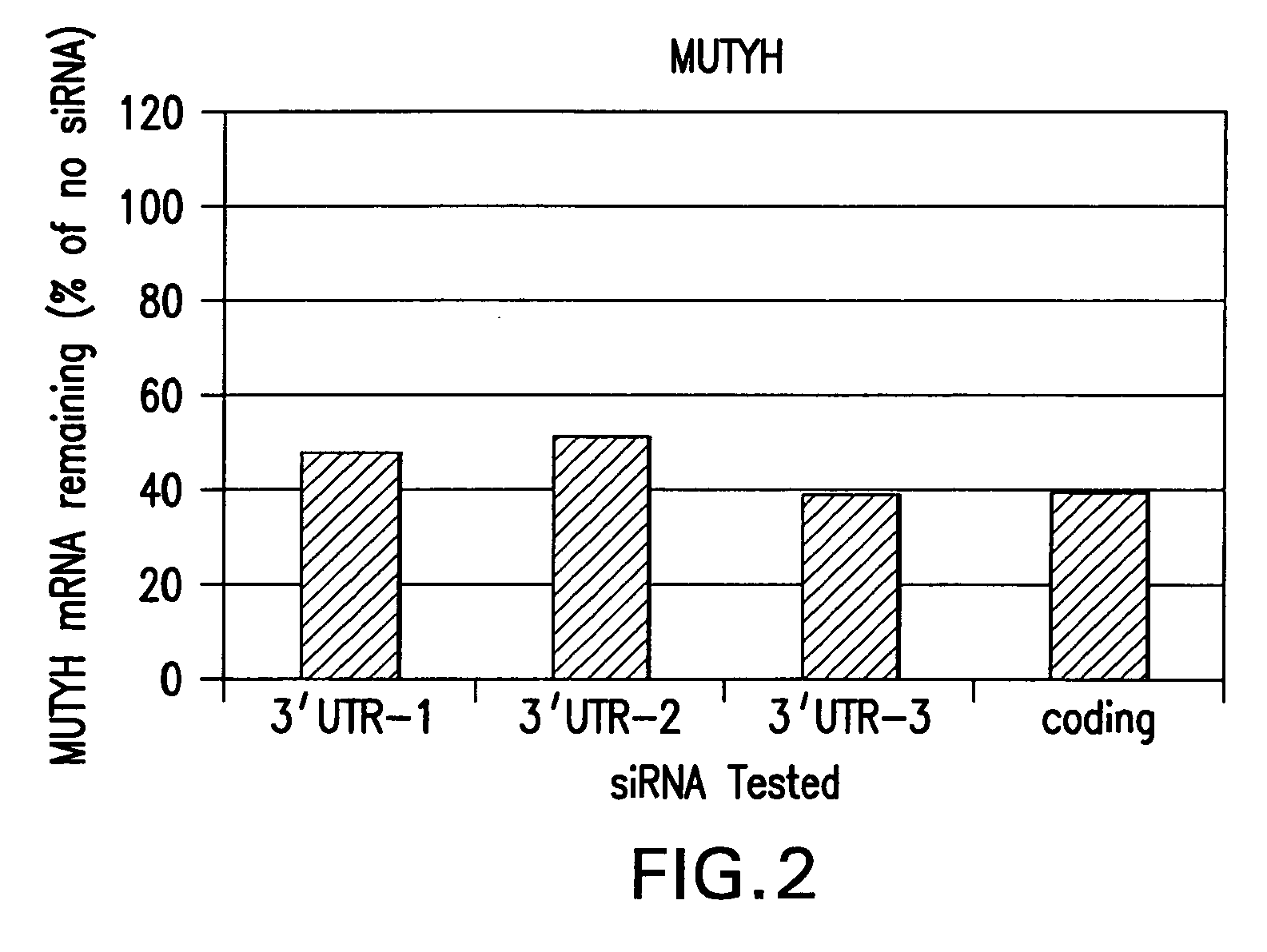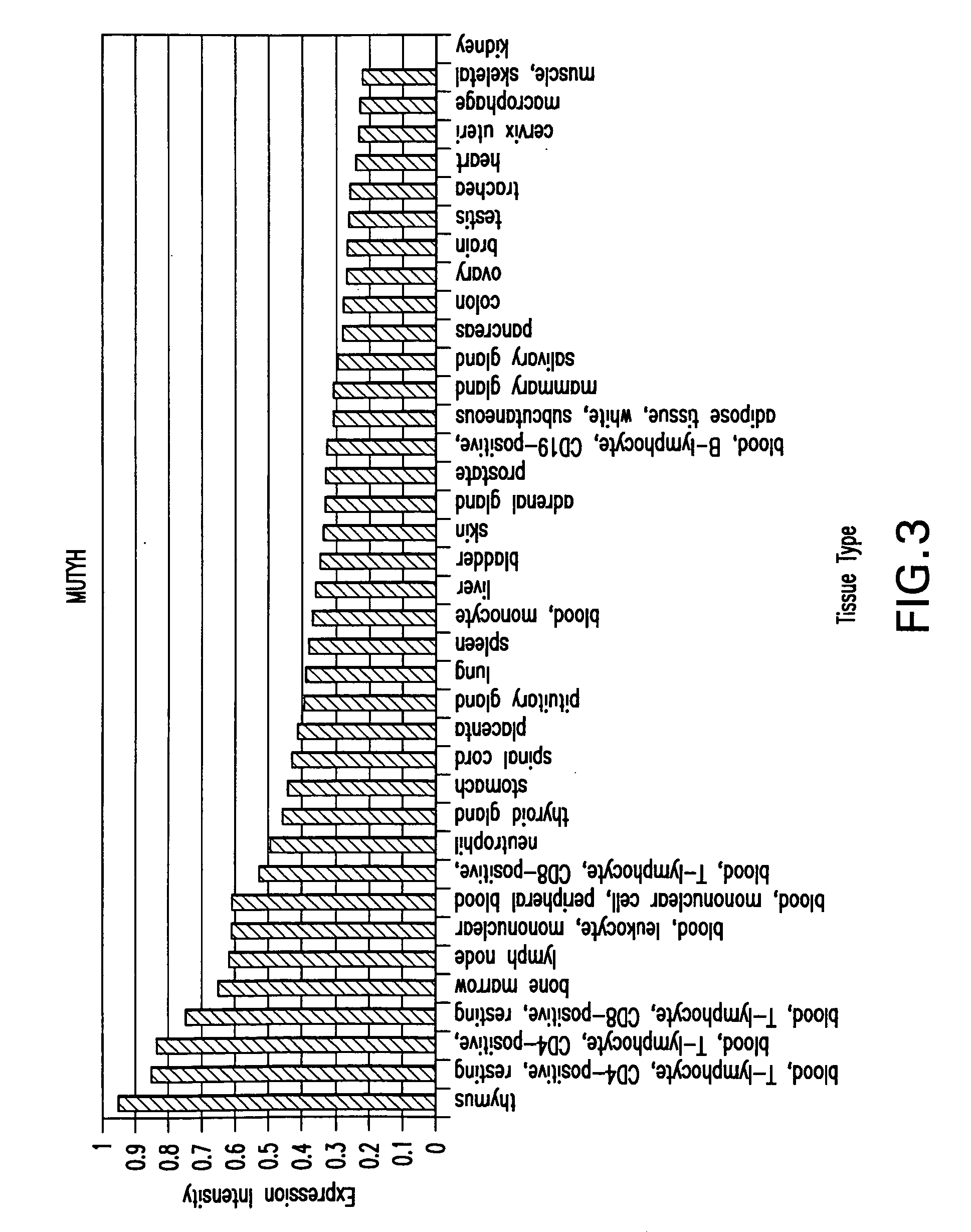Novel HIV targets
- Summary
- Abstract
- Description
- Claims
- Application Information
AI Technical Summary
Benefits of technology
Problems solved by technology
Method used
Image
Examples
example 1
Inhibition of HIV Infection by NEIL3 siRNAs
[0049]The following protocol was used for all siRNA experiments:
[0050]Day 1: P4 / R5 HeLa cells were plated at 500 cells per well into 384-well plates
[0051]Day 2: P4 / R5 HeLa cells were transfected with siRNA pools as follows:[0052]1. siRNAs were transfected in triplicate at a final concentration of 50 nM[0053]2. Oligofectamine (Invitrogen) was added at a final concentration of 0.5%.
Positive and negative control siRNAs were included as follows:[0054]Cyclin T1 (positive control): purchased from Santa Cruz Biotechnology (cat #sc-35144)[0055]CCNT1-1 (positive control): CCCACAUACUCAUGUAGUAdTdT (SEQ ID NO: 1)[0056]CCNT1-4 (positive control): CUUAACGUCUCACAAUUGAdTdT (SEQ ID NO:2)[0057]TSG101 (positive control): a pool of equal proportions of GCCUUAUAGAGGUAAUACAdTdT (SEQ ID NO:3), CUCAAUGCCUUGAAACGAAdTdT (SEQ ID NO: 4), and GAGAUGAACCUCCAGUCUUdTdT (SEQ ID NO: 5)[0058]PLK1, a control for transfection efficiency, GAGACCUACCUCCGGAUCA (SEQ ID NO: 6)[0059...
example 2
NEIL3 siRNAs are not Cytotoxic
[0085]Because NEIL3 siRNAs were identified via their inhibition of HIV infectivity, it is possible that these siRNAs appeared as hits in the infectivity screen simply due to cytotoxicity. For this reason, the NEIL3 siRNA pool was examined for cytotoxic effects in the cytotoxicity assay as described in Example 1. siRNAs that resulted in viability levels of less than 70%, as determined by Alamar Blue fluorescence, were considered to be cytotoxic. The NEIL3 siRNAs did not show any evidence of cytotoxicity following transfection into HeLa P4 / R5 cells.
example 3
NEIL3 siRNAs Inhibit Production of Infectious Virus
[0086]In the original screen, the siRNAs were transfected into the same cells that were used to assess viral infectivity. As a result, any siRNAs that directly affected transcription, translation, or enzymatic activity of the LTR-driven β-galactosidase reporter genes would affect the outcome of the assay and be recorded as hits. To eliminate these hits, an assay was developed in which HeLa P4 / R5 cells were transfected with siRNAs, infected with virus, and then virus that was shed after several rounds of infection was used to infect freshly plated HeLa (P4 / R5) cells.
[0087]Day 1: HeLa (P4 / R5) cells were plated at 1000 cells per well into 384-well Falcon plates (Cat# 353988).
[0088]Day 2: HeLa (P4 / R5) cells were transfected with siRNA pools as follows:[0089]1. siRNAs, including the siRNA pool for NEIL3 described in Example 1 were transfected in triplicate at a final concentration of 50 nM using Oligofectamine (Invitrogen) at a final con...
PUM
 Login to View More
Login to View More Abstract
Description
Claims
Application Information
 Login to View More
Login to View More - R&D
- Intellectual Property
- Life Sciences
- Materials
- Tech Scout
- Unparalleled Data Quality
- Higher Quality Content
- 60% Fewer Hallucinations
Browse by: Latest US Patents, China's latest patents, Technical Efficacy Thesaurus, Application Domain, Technology Topic, Popular Technical Reports.
© 2025 PatSnap. All rights reserved.Legal|Privacy policy|Modern Slavery Act Transparency Statement|Sitemap|About US| Contact US: help@patsnap.com



